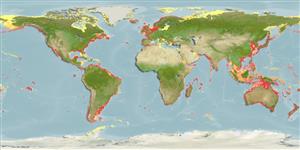Common names from other countries
Classification / Names / Names
Namen | Synonyme | Catalog of Fishes (gen., sp.) | ITIS | CoL | WoRMS
Environment: milieu / climate zone / depth range / distribution range
Ökologie
; tiefenbereich 0 - 80 m (Ref. 1603). Tropical; 68°N - 76°S, 180°W - 180°E
Circumglobal.
Length at first maturity / Size / Gewicht / Alter
Maturity: Lm ? range ? - ? cm Max length : 0.1 cm TL Männchen/unbestimmt; (Ref. 2226)
Assumed maximum length of zooids from Ref. 2226. Found also on dead corals. Attached to hard substrata (Ref. 1603); from low water level (Ref. 226) to depth of about 80 m (Ref. 1603); occurs in mangrove ponds (Ref. 1758). Colonial (Ref. 415).
Life cycle and mating behavior
Geschlechtsreife | Fortpflanzung | Ablaichen | Eier | Fecundity | Larven
Members of the class Ascidiacea are hermaphroditic; both cross- and self-fertilization is typical. Life cycle: Eggs develop into lecithotrophic larva before metamorphosing into benthic adults.
Sanamyan, K. and D. Schories. 2004. (Ref. 3379)
IUCN Rote Liste Status (Ref. 130435)
CITES Status (Ref. 108899)
Not Evaluated
Not Evaluated
Nutzung durch Menschen
| FishSource |
Tools
Mehr Information
Alter/GrößeWachstumLänge-GewichtLänge-LängeMorphologieLarvenDichte
Internet Quellen
Estimates based on models
Preferred temperature
(Ref.
115969): 7.3 - 27.9, mean 18.3 (based on 3200 cells).
Verwundbarkeit
Low vulnerability (10 of 100).
Preiskategorie
Unknown.
